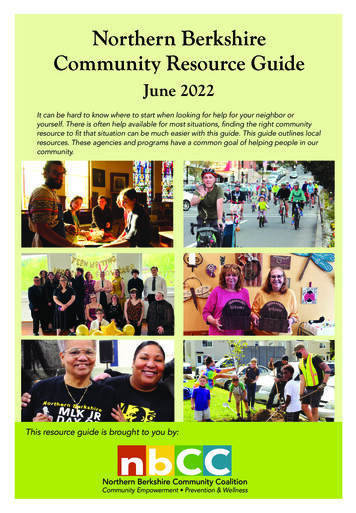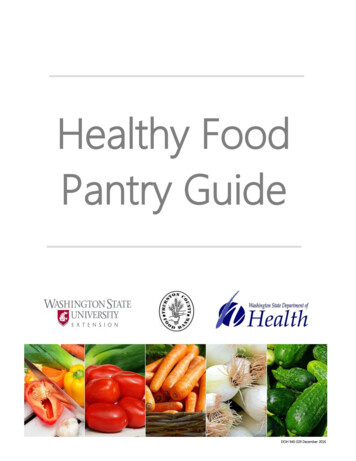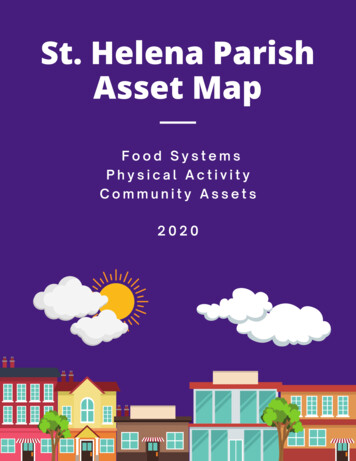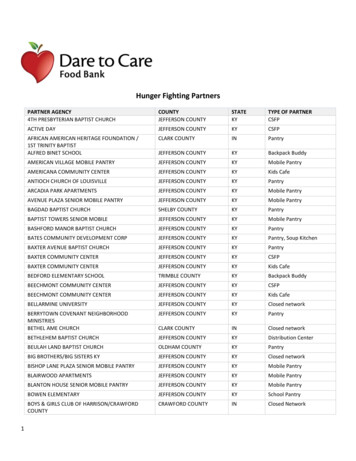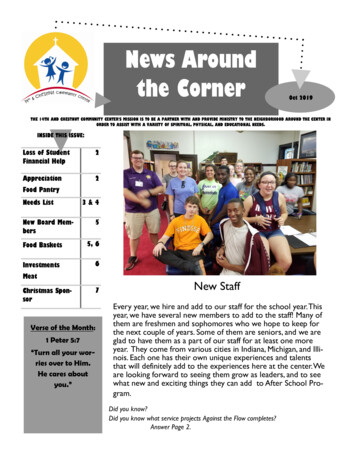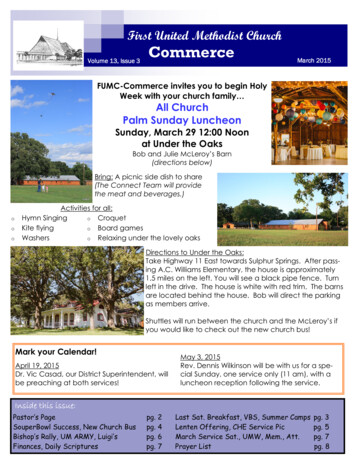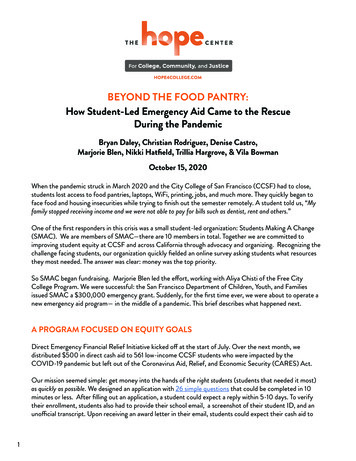
Transcription
BEYOND THE FOOD PANTRY:How Student-Led Emergency Aid Came to the RescueDuring the PandemicBryan Daley, Christian Rodriguez, Denise Castro,Marjorie Blen, Nikki Hatfield, Trillia Hargrove, & Vila BowmanOctober 15, 2020When the pandemic struck in March 2020 and the City College of San Francisco (CCSF) had to close,students lost access to food pantries, laptops, WiFi, printing, jobs, and much more. They quickly began toface food and housing insecurities while trying to finish out the semester remotely. A student told us, “Myfamily stopped receiving income and we were not able to pay for bills such as dentist, rent and others.”One of the first responders in this crisis was a small student-led organization: Students Making A Change(SMAC). We are members of SMAC—there are 10 members in total. Together we are committed toimproving student equity at CCSF and across California through advocacy and organizing. Recognizing thechallenge facing students, our organization quickly fielded an online survey asking students what resourcesthey most needed. The answer was clear: money was the top priority.So SMAC began fundraising. Marjorie Blen led the effort, working with Aliya Chisti of the Free CityCollege Program. We were successful: the San Francisco Department of Children, Youth, and Familiesissued SMAC a 300,000 emergency grant. Suddenly, for the first time ever, we were about to operate anew emergency aid program— in the middle of a pandemic. This brief describes what happened next.A PROGRAM FOCUSED ON EQUITY GOALSDirect Emergency Financial Relief Initiative kicked off at the start of July. Over the next month, wedistributed 500 in direct cash aid to 561 low-income CCSF students who were impacted by theCOVID-19 pandemic but left out of the Coronavirus Aid, Relief, and Economic Security (CARES) Act.Our mission seemed simple: get money into the hands of the right students (students that needed it most)as quickly as possible. We designed an application with 26 simple questions that could be completed in 10minutes or less. After filling out an application, a student could expect a reply within 5-10 days. To verifytheir enrollment, students also had to provide their school email, a screenshot of their student ID, and anunofficial transcript. Upon receiving an award letter in their email, students could expect their cash aid to1
quickly follow. If a student was eligible for the grant but hadn’t submitted all of the necessary documentationthey received an email regarding pending paperwork. Additionally, we compiled a list of these pendingstudents to give to the retention program staff. Staff from the retention program emailed and calledstudents to see if they had questions or required assistance with enrollment.Students could receive their money by check, Venmo, Paypal, or gift card. This allowed all students toreceive money easily by eliminating any potential barriers such as not having a bank account, a license,citizenship status, a smart phone, etc. However, most students received checks because Venmo and Paypallimit the number of transactions one can process per week.OUTREACH AND COMMUNICATIONSWe did two major rounds of outreach and distribution. The first round of outreach centered on Black andLatinx students, since data shows that those populations are met with the greatest barriers to receiving aid.Our second round of outreach was broader, allowing us to reach other communities of color along with whitestudents that were disenfranchised due to income, country of origin, involvement in the justice or foster caresystem, etc.To get the message about the program out tostudents, we posted videos on social mediaannouncing the program and held an Instagram Liveto explain it in more detail. We also posted onlineflyers to all our social media accounts.As we designed the outreach materials, we focusedon the “AHUY method”: Agitate, Hope, Urgency,You. Our flyer and messaging was intended toagitate (Are you a continuing CCSF studentthat was excluded from the CARES Act?), bringhope (Students Making A Change wants to help!Apply for 500), promote urgency (limited grantsavailable), and focus on you (You do not want tomiss out, go to our website to apply and learn moreabout the grant).We also encouraged grant recipients to accessresources that would help them with their ongoingstudies at CCSF. We created a streamlined websitededicated to connecting students with campussupport services as well as a number of shortinstructive videos with eye-catching titles.2
Streamline website to supportstudents during COVID-19In our effort to help reduce anxiety, we are offeringconnections to essential line website connectingstudents with campus supportservicesPlease schedule an appointment with one of these greatpeople at CCSF who can support you:studentsmakingchange.org/ccsfsupportShort instructive videos witheye-catching titlesGet more money! Watch this short video about applyingfor scholarships.Get your classes! Watch this short video about how touse assist.org.Finish English and Math classes at CCSF in one year!Watch this short video about the law that allows you todo this.IMPACTWe succeeded in achieving our goals. All of the 561 grants went to students who did not receive aid fromthe CARES Act: including undocumented students, students with DACA status, citizens who have notcompleted a federal financial aid application, non-citizens, former foster-care youth, international students,and justice-impacted students. Fully 94% of the recipients were students of color: 42% were Asian, 33%were Latinx, and 11% were African American. Eighty percent of recipients reported an income of 15,000 orless. One in three recipients was a parenting student, and 76% was a first-generation college student. Fully80% of the recipients said that they were experiencing at least one of the following challenges: 3I do not have a permanent place to stayI am currently in an unsafe living situationI am experiencing difficulty obtaining enough food for myself and/or my familyI have expenses I am currently unsure how I will coverI do not have the resources I need in order to take my classesI lost my financial aid or scholarshipI am a student commuting from outside of San FranciscoI have been priced out of living in the Bay Area
Each of these students received 500 in the summer following the onset of the pandemic to supportessentials such as groceries, rent and utilities, medical bills, and educational costs, amongst others.Students informed us that financial insecurity was affecting their physical, mental, and emotional health.These grants provided some mental relief for students as they were able to meet their basic needs for thatmonth. Additionally, students commented that they felt supported, loved, and seen by receiving this cashaid. It gave them hope and made them feel that they weren’t alone. You can read many student testimonialshere.“I work in the restaurant industry and because of that I have been struggling to pay rent andfood. I’ve been experiencing panic attacks and it’s really bad having those sensations. Mostof my family are not working so I have had to help them financially but all my savings that Ihad are gone. This financial support will help me to pay my rent and that way I will have somerelief.”Students also began to build or rebuild trusting relationships with college support staff/systems. With thecampus being closed many students felt disconnected from their college community and no longer knewwhere to go for support or assistance. By using the Direct Emergency Financial Relief Initiative as anengagement strategy, students were both given clear, accessible information about how to re-engage andwere incentivized to do so. This effort has resulted in hundreds of students re-enrolling at CCSF for fallsemester 2020 – continuing their educational journey towards greater financial security for themselves andtheir families.WHAT MATTERED MOST: TRUST, CONNECTION, ENGAGEMENTAs we think about the work we did together, we notice that several aspects were intentional and strategic.Three elements in particular helped us succeed.1. We engaged trusted partners and allies: We began by partnering with CCSF’s retention programs asthey serve historically underserved equity populations including undocumented students, low-incomestudents, and students of color. We then connected to additional campus programs that served abroader group of students. We asked that programs: (1) inform their students about the 500 grant byphone and emails; (2) support their students with applying to the grant; and (3) support their studentswith enrolling in CCSF for Fall 2020 to meet the grant requirement. These partnerships were fruitfulbecause SMAC has cultivated and maintained relationships with these programs over many years.We also partnered with Coleman Advocates for administrative support so that the workload would bemanageable.4
2. We focused on personal connections: We held Zoom meetings that included video tutorials clearlylaying out each step of the application process and allowed students to ask questions. Retention programcoordinators participated in the Zoom sessions and were the primary contact inviting students to thesessions. Students had a trusting relationship with the coordinators. This seemed to be an essentialelement facilitating their willingness to learn more about and eventually apply for the emergency grant.3. We leverage direct aid as an engagement strategy: We knew that in addition to a one-time grant of 500, CCSF students would need tangible on-going support to get them through the pandemic andthe long-lasting future repercussions of the pandemic. Students approved for cash aid had to completean engagement requirement along with receiving their 500. Options included scheduling a counselingappointment, scheduling an appointment to create an educational plan, or attending a Zoom eventwith the retention program. The program staff had seen a significant drop in student engagement afterin-person programming had ended as a result of COVID-19. Retention program staff said that studentinvolvement significantly improved thanks to this grant program requirement – new and former studentsused their services to enroll in the fall 2020 semester as well as connect to long-term support options.Students felt new levels of support during this challenging time and strengthened trusting relationshipsthat they will be able to turn to in the future.WHAT’S NEXT FOR SMACAcross California, SMAC is advocating to increase financial aid to cover the total cost of community collegebeyond tuition and fees such as food, housing, health care and other basic needs. Locally we are currentlyasking City College of San Francisco to match our efforts in distributing over 300,000 worth of basicneeds support to students. How can you help? SMAC is asking foundations, community colleges, andcommunity members to donate to SMAC’s Direct Emergency Financial Aid Relief program. Students needyour help right now— any contribution helps.AUTHORSBryan Daley is a SMAC Fellow Alumni, currentstudent at UC Berkeley, and member of theCalifornia Higher Education Recovery with EquityTaskforce.Christian Rodriguez is a SMAC Senior Fellow,graduated from City College of San Francisco,and is pursuing Sociology with an emphasis onrehabilitation with people who have gone throughthe prison system.Denise Castro is SMAC’s Program Coordinator andreceived her B.A. and M.A. from the University ofCalifornia, Merced.5Marjorie Blen is SMAC’s Interim ProgramCoordinator, current student at San Francisco StateUniversity, and mother of two boys.Nikki Hatfield is a SMAC Senior Fellow, currentstudent at City College of San Francisco, memberof the Free City Oversight committee, and secondgeneration San Franciscan.Trillia Hargrove is a SMAC Fellow, current studentat City College of San Francisco, and studyingPsychology.Vila Bowman is a SMAC Fellow Alumni, graduatedfrom City College of San Francisco, current studentat California Institute of Integral Studies, andmother of two daughters.
This brief carries a Creative Commons Attributions 4.0 International License, which permits re-use of HopeCenter materials providing that re-use abides by the conditions below.You are free to:Share. Copy and redistribute the material in any medium or formatUnder the following terms:Attribution. You must give appropriate credit, provide a link to the license, and indicate if changes weremade. You may do so in any reasonable manner, but not in any way that suggests the licensor endorses youor your use.NonCommercial. You may not use the material for commercial purposes.NoDerivatives. If you remix, transform, or build upon the material, you may not distribute the modifiedmaterial.For the full legal code of this Creative Commons license, please /4.0/legalcode6
When the pandemic struck in March 2020 and the City College of San Francisco (CCSF) had to close, students lost access to food pantries, laptops, WiFi, printing, jobs, and much more. . Finish English and Math classes at CCSF in one year! Watch this short video about the law that allows you to do this. IMPACT



